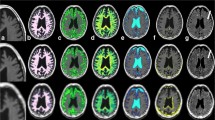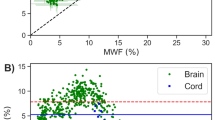Abstract
Partial volume averaging of signal from multiple sclerosis lesions influences biexponential fitting of the water T2 relaxation as used for tissue/CSF segmentation of spectroscopic volumes. Periventricular volumes-of-interest comprising CSF, lesion and normal-appearing white matter in varying proportion were studied. The relaxation of the localized water signal was measured at 12 echo times (STEAM, geometric spacing from 30 ms to 2000 ms, least-squares fit). Magnetization transfer (MT) was applied to identify contributions of tissue signal to the CSF component. The T2 of the long-lived component (T2long=433–1782 ms) and its prolongation after MT were inversely correlated to the MT ratio. Hence, short T2long is associated with overestimation of CSF partial volume, and thus metabolite concentrations. A T2-correction for the CSF partial volume was suggested and applied to the quantification of MR spectra of large MS lesions. The T2 of bulk CSF (2280±87 ms) and the influence of the TE sampling scheme were also studied.




Similar content being viewed by others
References
Ernst T, Kreis R, Ross BD (1993) Absolute quantification of water and metabolites in the human brain. I. Compartments and water. J Magn Reson B102:1–8
Kreis R, Ernst T, Ross BD (1993) Absolute quantification of water and metabolites in the human brain. II. Metabolite concentrations. J Magn Reson B102:9–19
Danielsen ER, Ros BD (1995) Problems and solutions of quantitative MRS in diseased brain. In: 3rd Proc Intl Soc Magn Reson Med, San Francisco, p. 256
Barnes D, Munro PMG, Youl BD, Prineas JW, McDonald WI (1991) The longstanding MS lesion. A quantitative MRI and electron microscopy study. Brain 114:1271–1280
Helms G, Piringer A (2001) Magnetization transfer of water T2 relaxation components in human brain: Implications for T2-based segmentation of spectroscopic volumes. Magn Reson Imaging 19:803–811
Helms G (2001) Volume correction for edema in single volume proton MR spectroscopy of contrast enhancing multiple sclerosis lesions. Magn Reson Med 46:256–263
Whittall KP, MacKay AL, Li DKB (1999) Are mono-exponential fits to a few echoes sufficient to determine T2 relaxation for in human brain? Magn Reson Med 41:1255–1257
Webb PG, Sailatsuta N, Kohler SJ, Raidy T, Moats RA, Hurd RE (1994) Automated single-voxel proton MRS: Technical development and multisite verification. Magn Reson Med 31:365–373
Helms G (2000)A precise and user-independent quantification technique for regional comparison of single volume proton MR spectroscopy of the human brain. NMR Biomed 13:398–406
Piringer A. , M.Sc. Thesis, Stockholm University, 1998
Helms G, Stawiarz L, Kivisäkk P, Link H (2000) Regression analysis of metabolite concentrations estimated from localized proton MR spectra of active and chronic multiple sclerosis lesions. Magn Reson Med 43:102–110
Helms G, Piringer A (2001) Restoration of motion-related signal loss and line-shape deterioration of proton MR spectra using the residual water as intrinsic reference. Magn Reson Med 46:395–400.
Provencher SW (1993) Estimation of metabolite concentrations from localized in vivo proton NMR spectra. Magn Reson Med 30:672–679
Helms G (1999) Analysis of 1.5 Tesla proton MR spectra of human brain using LCModel and an imported basis set. Magn Reson Imag 17:1211–1218
MacKay A, Whittall K, Adler J, Li D, Paty D, Graeb D (1994) In vivo visualization of myelin water in brain by magnetic resonance. Magn Reson Med 31:673–677
Provencher SW (1976) An eigenfunction expansion method for the analysis of exponential decay curves. J Chem Phys 64:2772–2777
Whittall KP, MacKay AL, Graeb DA, Nugent RA, Li DKB, Paty DW (1997) In vivo measurements of T2 distributions and water content in normal human brain. Magn Reson Med 37:34–43
Greitz D, Wirestam R, Franck A, Nordell B, Thomsen C, Ståhlberg F (1992) Pulsatile brain movement and associated hydrodynamics studies by magnetic resonance phase imaging. Neuroradiology 34:370–380
Brownstein KR, Tarr CE (1979) Importance of classical diffusion in NMR studies of water in biological cells. Phys Rev A19:2446–2449
Acknowledgements
The cooperation of the patients and staff of the Division of Neurology, Huddinge University Hospital of the Karolinska Institute is gratefully acknowledged. The author is indebted to Dan Greitz for discussions of CSF flow, to Leszek Stawiarz for organizational assistance, and to Andreas Piringer for implementing the MT pre-saturation.
Author information
Authors and Affiliations
Corresponding author
Rights and permissions
About this article
Cite this article
Helms, G. T2-based segmentation of periventricular volumes for quantification of proton magnetic resonance spectra of multiple sclerosis lesions. MAGMA 16, 10–16 (2003). https://doi.org/10.1007/s10334-003-0006-8
Received:
Accepted:
Published:
Issue Date:
DOI: https://doi.org/10.1007/s10334-003-0006-8




